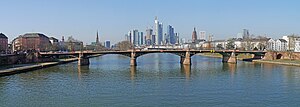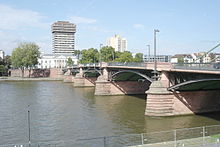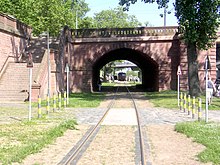Ignatz-Bubis Bridge
Coordinates: 50 ° 6 ′ 29 ″ N , 8 ° 41 ′ 34 ″ E
|
|
||
|---|---|---|
| use | Road bridge | |
| Convicted | Bundesstrasse 3 | |
| Crossing of | Main | |
| place |
Downtown Sachsenhausen (Main km 36.00) |
|
| construction | Sub-arch steel framework |
|
| overall length | 183.75 | |
| width | 14.50 m | |
| Headroom | 6.20 m | |
| construction time | 1949 | |
| location | ||
|
|
||
The Ignatz-Bubis Bridge (until 2000 Obermainbrücke ) is a road bridge in Frankfurt am Main . At Main - kilometer 36.0, it connects the Obermainanlage in the city center district with Dreieichstrasse in Sachsenhausen . It is 183.75 meters long and 15.20 meters wide. The federal highway 3 , the tram line 18 and the Ebbelwei-Express lead over the bridge . In December 2000 the bridge was named after the chairman of the Central Council of Jews in Germany , Ignatz Bubis , who died in 1999 .
history
Various bridge building projects have been discussed in Frankfurt since the middle of the 19th century in order to relieve the very narrow Old Bridge , which dates back to the Middle Ages . After the annexation of the Free City of Frankfurt by Prussia in 1866, the Eiserne Steg was built as a pedestrian bridge downstream of the Old Bridge , then the Untermain Bridge from 1872 to 1874 .
On the other hand, the need for and construction of an upstream bridge has long been debated in the city councils. It was not until 1875 that it was decided to build another bridge, the Obermainbrücke .
It was built from 1876 to 1878 based on a design by Peter Schmick as the fifth Main Bridge in Frankfurt. Apart from a narrow stone arch on the north bank through which the connecting railway runs, the other five bridge arches consisted of a wrought iron framework. The five bridge piers were made of red Main sandstone, their foundations poured from concrete . The span of the outer arches is 33.25 meters, that of the neighboring arches 38.50 meters, while the middle arch is 40.25 meters wide.
In 1881 a horse-drawn tram operated by the Frankfurt tram company ran across the bridge for the first time . In 1900 the line was electrified.
Due to severe rust damage to the wrought iron truss arches, the bridge had to be closed to traffic in 1934. It only remained open to pedestrian traffic. The bridge was not repaired because of the strained raw material situation.
At least two works by the artist Albert Windisch had the bridge as a motif, the first from 1920 and the second shows the use of pedestrians.
In 1944, the bridge was damaged by aerial bombs in the air raids on Frankfurt am Main . On March 26, 1945, the two middle arches along with the other Main bridges were blown up by an explosive force of the Wehrmacht .
In April 1946, the reconstruction of the bridge began. The exterior of the construction remained unchanged, but the pillars were made of concrete and the bridge arches were made of steel. On June 4, 1949 the rebuilt bridge was opened to traffic. The original construction costs from 1876 to 1878 had 1,040,000 Mark amount, the rebuilding cost 5,000,000 DM .
In 1964, another, initially provisional, bridge, the Flößerbrücke , was built about 70 meters above the Obermainbrücke . Road traffic to the north was routed through it, while the Obermainbrücke was only used in the direction of Sachsenhausen in future.
In the eighties, severe wear and corrosion damage appeared again on the bridge, which made renovation necessary. After the new Flößerbrücke was built, the Obermainbrücke could be closed. The renovation began in April 1986 and was completed in February 1988. The bridge was widened by about 1.50 meters and the load-bearing capacity increased from 45 to 60 tons.
The renaming of the bridge
In September 2000 the city council decided with the votes of the SPD , the Greens and the FDP to rename the Obermainbrücke in honor of Ignatz Bubis, who died in 1999, to the Ignatz-Bubis-Brücke . The CDU abstained from the vote.
See also
literature
- Walter Gerteis, The Unknown Frankfurt. Third episode . Frankfurt am Main 1963. Publishing house Frankfurter Bücher.
- Wolfram Gorr, Frankfurter Brücken , Societäts-Verlag, Frankfurt am Main 1982, ISBN 3-7973-0393-9
- Wolf-Christian Setzepfandt : Architecture Guide Frankfurt am Main / Architectural Guide . 3. Edition. Dietrich Reimer Verlag, Berlin 2002, ISBN 3-496-01236-6 , p. 30 (German, English).
Web links
- Ignatz-Bubis Bridge. In: Structurae
- The reconstruction of the inner city bridges. Archived from the original on October 8, 2011 ; Retrieved May 7, 2014 .
- Ignatz-Bubis-Brücke ( Memento from September 30, 2007 in the Internet Archive ), article by Heinrich Lorentz ( PDF )
Individual evidence
- ^ Federal Waterways and Shipping Administration: Route Atlas Main I. (PDF 11 MB) (No longer available online.) 2010, p. 42 , archived from the original on January 14, 2015 ; Retrieved January 18, 2015 .




